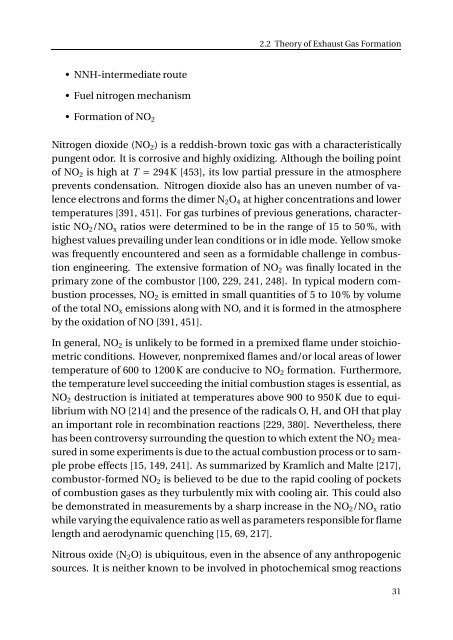On the Formation of Nitrogen Oxides During the Combustion of ...
On the Formation of Nitrogen Oxides During the Combustion of ...
On the Formation of Nitrogen Oxides During the Combustion of ...
Create successful ePaper yourself
Turn your PDF publications into a flip-book with our unique Google optimized e-Paper software.
2.2 Theory <strong>of</strong> Exhaust Gas <strong>Formation</strong><br />
• NNH-intermediate route<br />
• Fuel nitrogen mechanism<br />
• <strong>Formation</strong> <strong>of</strong> NO 2<br />
<strong>Nitrogen</strong> dioxide (NO 2 ) is a reddish-brown toxic gas with a characteristically<br />
pungent odor. It is corrosive and highly oxidizing. Although <strong>the</strong> boiling point<br />
<strong>of</strong> NO 2 is high at T = 294K [453], its low partial pressure in <strong>the</strong> atmosphere<br />
prevents condensation. <strong>Nitrogen</strong> dioxide also has an uneven number <strong>of</strong> valence<br />
electrons and forms <strong>the</strong> dimer N 2 O 4 at higher concentrations and lower<br />
temperatures [391, 451]. For gas turbines <strong>of</strong> previous generations, characteristic<br />
NO 2 /NO x ratios were determined to be in <strong>the</strong> range <strong>of</strong> 15 to 50 %, with<br />
highest values prevailing under lean conditions or in idle mode. Yellow smoke<br />
was frequently encountered and seen as a formidable challenge in combustion<br />
engineering. The extensive formation <strong>of</strong> NO 2 was finally located in <strong>the</strong><br />
primary zone <strong>of</strong> <strong>the</strong> combustor [100, 229, 241, 248]. In typical modern combustion<br />
processes, NO 2 is emitted in small quantities <strong>of</strong> 5 to 10% by volume<br />
<strong>of</strong> <strong>the</strong> total NO x emissions along with NO, and it is formed in <strong>the</strong> atmosphere<br />
by <strong>the</strong> oxidation <strong>of</strong> NO [391, 451].<br />
In general, NO 2 is unlikely to be formed in a premixed flame under stoichiometric<br />
conditions. However, nonpremixed flames and/or local areas <strong>of</strong> lower<br />
temperature <strong>of</strong> 600 to 1200 K are conducive to NO 2 formation. Fur<strong>the</strong>rmore,<br />
<strong>the</strong> temperature level succeeding <strong>the</strong> initial combustion stages is essential, as<br />
NO 2 destruction is initiated at temperatures above 900 to 950 K due to equilibrium<br />
with NO [214] and <strong>the</strong> presence <strong>of</strong> <strong>the</strong> radicals O, H, and OH that play<br />
an important role in recombination reactions [229, 380]. Never<strong>the</strong>less, <strong>the</strong>re<br />
has been controversy surrounding <strong>the</strong> question to which extent <strong>the</strong> NO 2 measured<br />
in some experiments is due to <strong>the</strong> actual combustion process or to sample<br />
probe effects [15, 149, 241]. As summarized by Kramlich and Malte [217],<br />
combustor-formed NO 2 is believed to be due to <strong>the</strong> rapid cooling <strong>of</strong> pockets<br />
<strong>of</strong> combustion gases as <strong>the</strong>y turbulently mix with cooling air. This could also<br />
be demonstrated in measurements by a sharp increase in <strong>the</strong> NO 2 /NO x ratio<br />
while varying <strong>the</strong> equivalence ratio as well as parameters responsible for flame<br />
length and aerodynamic quenching [15, 69, 217].<br />
Nitrous oxide (N 2 O) is ubiquitous, even in <strong>the</strong> absence <strong>of</strong> any anthropogenic<br />
sources. It is nei<strong>the</strong>r known to be involved in photochemical smog reactions<br />
31
















